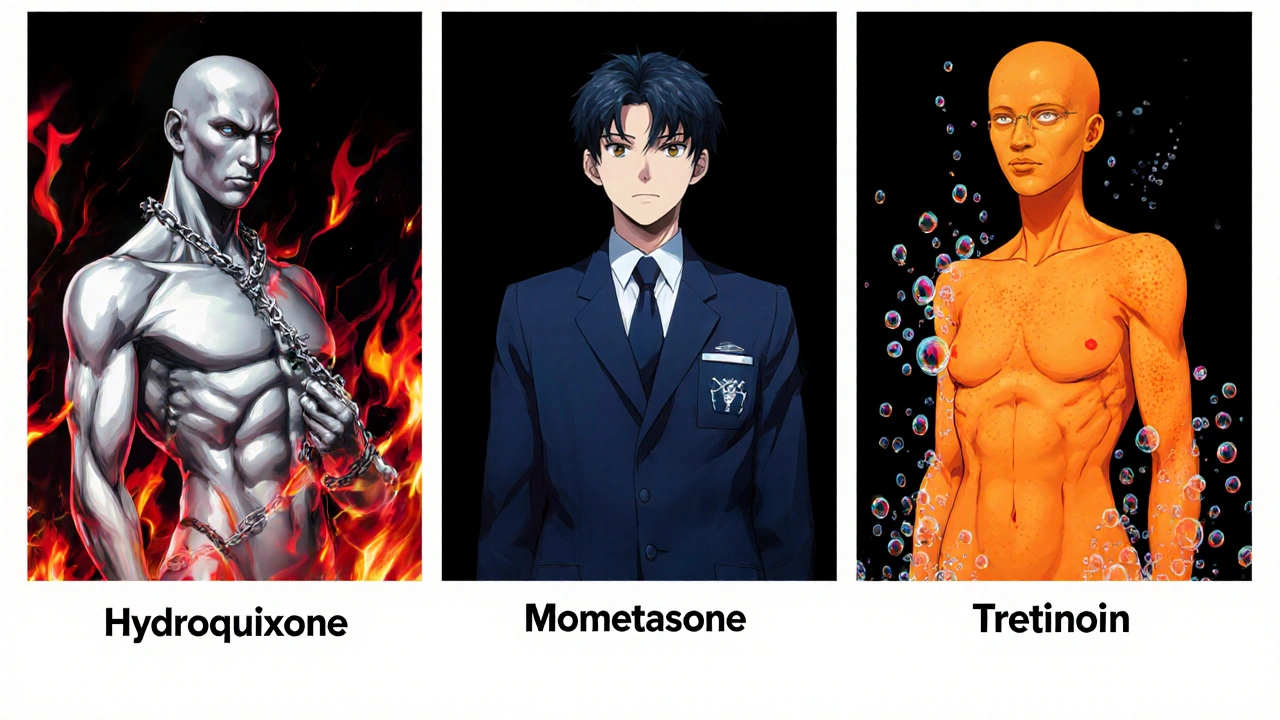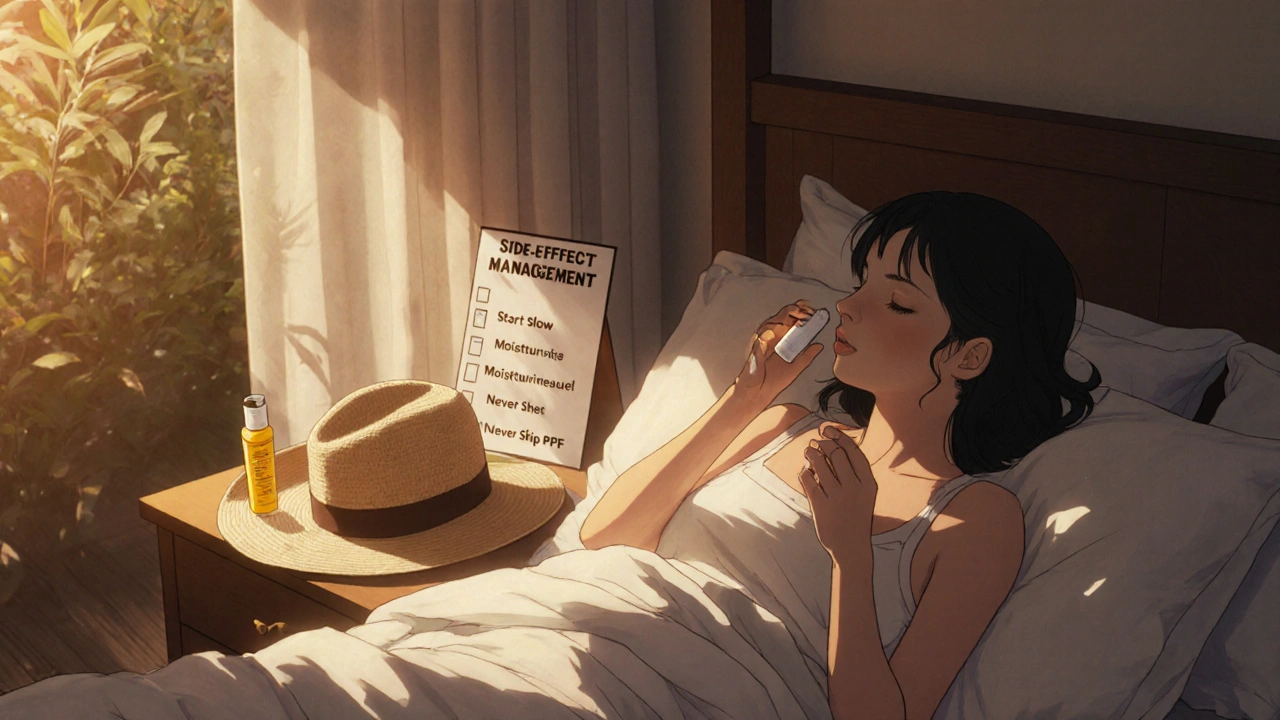Side Effect Checker for Hydroquinone Mometasone Tretinoin Cream
Identify Your Side Effect
Select your current symptom from the list below to get targeted management advice.
Side Effect Information
Select a symptom to get management advice.
Ever started a new skin cream and ended up with itching, redness, or weird flaking? That’s the body’s way of telling you something’s off. When you’re using a powerful blend like Hydroquinone Mometasone Tretinoin cream is a prescription topical blend that combines a skin‑lightening agent, a corticosteroid, and a retinoid to treat stubborn hyperpigmentation and inflammatory skin conditions. It targets melanin overproduction, reduces inflammation, and promotes cell turnover, making it popular for melasma, post‑inflammatory hyperpigmentation, and resistant eczema., the side‑effect profile can feel overwhelming. This guide walks you through what to expect, how to soothe each reaction, and when you really need to call the doctor.
Why the Three‑Ingredient Combo Works
The three act together like a tag team:
- Hydroquinone blocks the enzyme tyrosinase, slowing melanin production.
- Mometasone is a mid‑strength corticosteroid that calms inflammation and reduces redness.
- Tretinoin accelerates skin cell turnover, helping the lighter cells rise to the surface faster.
Together they can shrink dark patches in weeks, but each brings its own potential irritation. Knowing the typical hydroquinone side effects and how they differ from mometasone or tretinoin reactions is the first step to staying comfortable.
Typical Side Effects - Ingredient by Ingredient
| Ingredient | Most Common Reactions | How Often They Appear |
|---|---|---|
| Hydroquinone | Redness, mild burning, dryness, ochronosis (rare) | 10‑30% of users |
| Mometasone | Stinging, thinning skin with prolonged use, acne‑like breakouts | 5‑15% of users |
| Tretinoin | Peeling, photosensitivity, itching, temporary worsening of acne | 20‑40% of users |
Notice the overlap: dryness and itching pop up for both hydroquinone and tretinoin, while mometasone tends to cause more steroid‑type issues like skin thinning if you stay on it longer than the prescribed 4‑6 weeks.
General Strategies That Help All Three
- Start Slow. Apply a pea‑sized amount every other night for the first week. If you tolerate it, increase to nightly use.
- Moisturize Aggressively. A barrier‑repair moisturizer containing ceramides, niacinamide, and hyaluronic acid keeps the skin hydrated and reduces the burning sensation.
- Sun Protection Is Non‑Negotiable. All three ingredients make your skin more photosensitive. Use a broad‑spectrum SPF 30+ sunscreen every morning, reapply every two hours outdoors.
- Avoid Other Actives. During the first month, stay away from AHAs, BHAs, benzoyl peroxide, and other retinoids. They can compound irritation.
- Patch Test. Before the full‑face application, test a tiny spot on the inner forearm for 48 hours. If you see a rash, reconsider the dosage.
These steps create a safety net, but sometimes a specific symptom needs a tailored fix.

Managing Hydroquinone‑Related Reactions
- Burning or Stinging. Apply a thin layer of a soothing gel (e.g., aloe‑vera or a 2.5 % lidocaine gel) after the cream dries. Reduce frequency until the sensation fades.
- Dryness and Flaking. Switch to a richer night cream containing shea butter or petrolatum for the first few nights.
- Ochronosis (rare hyperpigmentation). If you notice a bluish‑gray patch, stop using hydroquinone immediately and consult a dermatologist. Alternative agents like tranexamic acid or azelaic acid may be safer long‑term.
Handling Mometasone‑Induced Issues
- Acne‑Like Breakouts. Use a non‑comedogenic cleanser and a light, oil‑free moisturizer. If pimples persist, add a spot‑treatment with salicylic acid but only on non‑treated areas.
- Skin Thinning (if used beyond 6 weeks). Reduce application frequency to twice a week and incorporate a peptide‑rich serum to stimulate collagen production.
- Delayed Wound Healing. Avoid picking at scabs or doing aggressive exfoliation while mometasone is active.
Soothing Tretinoin Irritation
- Peeling. When you see visible flakes, switch to a “buffering” method: apply a thin moisturizer first, then the tretinoin on top.
- Photosensitivity. Apart from sunscreen, wear wide‑brim hats and seek shade during peak sun hours (10 am‑2 pm).
- Initial Acne Flare‑Ups. This is called the “purge.” Stick with the regimen for 2‑4 weeks; the breakout should subside. If it worsens, cut back to every other night.

When to Call Your Dermatologist
Most mild irritation can be managed at home, but watch for these red flags:
- Severe swelling, blistering, or pain that spreads beyond the treated area.
- Persistent redness lasting more than a week after you stopped the cream.
- Signs of infection - pus, foul odor, fever.
- Any unexpected color change, especially a gray‑blue hue indicating ochronosis.
Prompt medical advice can prevent a temporary annoyance from becoming a long‑term skin problem.
Quick‑Reference Checklist
- Start with every‑other‑night use → move to nightly if tolerated.
- Apply a ceramide‑rich moisturizer within 5 minutes of the cream.
- Never skip SPF 30+ in the morning.
- Stop the combo if you see severe burning, swelling, or discoloration.
- Schedule a dermatologist visit for any persistent or worsening symptoms.
Frequently Asked Questions
Can I use hydroquinone, mometasone, and tretinoin together?
Yes, many dermatologists prescribe the three‑drug blend for stubborn hyperpigmentation, but it must be used exactly as directed. The combination speeds up results but also raises the risk of irritation, so follow the tapering schedule.
How long should I stay on this cream?
Typically 8‑12 weeks, followed by a break of at least 4 weeks. Prolonged use increases the chance of steroid‑related thinning and hydroquinone‑induced ochronosis.
Is it safe to use during pregnancy?
Hydroquinone and tretinoin are classified as Category C - not recommended unless the benefits clearly outweigh risks. Talk to your OB‑GYN before starting.
What sunscreen SPF is best?
A broad‑spectrum SPF 30‑50 with zinc oxide or titanium dioxide offers physical protection without irritating the skin.
Can I add vitamin C serum?
Vitamin C can boost brightening, but introduce it only on nights when you skip the combo or wait at least 30 minutes after the cream to avoid extra irritation.

Joe Moore
I think the real reason they push that three‑drug combo is to keep us dependent on pricey prescriptions. The pharma giants love the hype around hydroquinone, mometasone and tretinoin because it guarantees a steady stream of money. They even fund the studies that say it works, so we never see the hidden risks. If you keep using it without a break you might be feeding the system that wants your skin to stay damaged. Stay sceptical and read the fine print before you let some lab coat decide what you put on your face.
Ayla Stewart
I understand your concerns, and I recommend following the dermatologist's guidelines to minimize irritation.
James Mali
Skin care routines can feel like a never‑ending philosophical puzzle. We chase the promise of flawless skin while ignoring the quiet cost of constant irritation. The hydroquinone‑mometasone‑tretinoin trio is a potent concoction that promises rapid results. Yet each component carries its own legacy of side effects that are often downplayed. Hydroquinone may cause redness and, in rare cases, ochronosis, a stubborn blue‑gray discoloration. Mometasone, a corticosteroid, can lead to skin thinning if used beyond the recommended period. Tretinoin accelerates cell turnover, which sounds great until the skin starts peeling like old paint. All three increase photosensitivity, making sunscreen an essential daily ritual. When you apply the cream, think of it as an experiment rather than a guaranteed cure. Patch testing on a small area of forearm can reveal hidden reactions before a full‑face application. Moisturizing aggressively with ceramide‑rich lotions can buffer the sting and dryness. If the burning persists, reducing the frequency to every other night often restores balance. The “purge” phase with tretinoin is a myth that masks the real inflammatory response of the skin. Patience, a gentle routine, and regular dermatologist check‑ups are far more valuable than shortcuts. Remember that the skin's natural barrier is its best defense; do not undermine it with over‑use. In the end, the choice to endure temporary discomfort for longer‑term brightening rests on informed consent, not on blind trust.
Janet Morales
You sound like you’re selling patience as a cure‑all, but most of us aren’t philosophers, we’re just people who want clear skin. The “experiment” you mention is a gamble that leaves many with permanent marks. I’d rather ditch the whole cocktail than risk turning my face into a research project. This regimen feels more like a marketing stunt than a medical solution.
Tracy O'Keeffe
Honestly, the whole hype around that tri‑mix is a theatrical performance orchestrated by the elite of dermatological commerce. They dress up a basic keratin disruptor in scientific jargon, hoping us mortals will swallow the narrative without a second thought. If you peel back the glossy brochure, you’ll see nothing more than a chemically‑laden shortcut that masquerades as miracles.
Emma Williams
I think the checklist is helpful. It makes the routine clear.